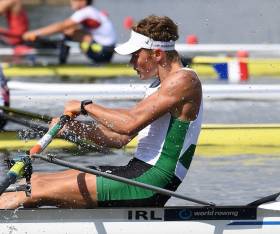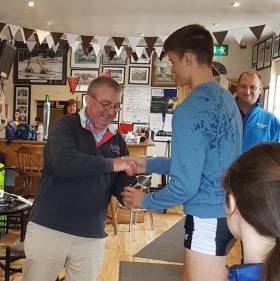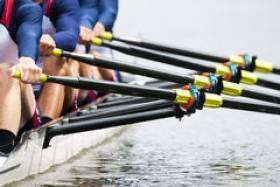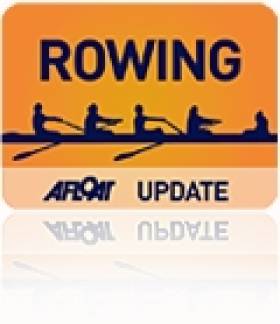Displaying items by tag: Time Trial
Sutton and Legresley Win Time Trial for Cork Sculling Ladder
#Rowing: Hugh Sutton of UCC Rowing Club was the overall winner of the 48th Cork Sculling Ladder time trial, which was run on calm water and on an outgoing tide at the Marina on the River Lee on Sunday. Sutton covered the 1800 metres in seven minutes and 3.4 seconds. Jessica Legresley of Shandon Boat Club won the women’s trial in 7:57.5.
Two previous winners of the the ladder, Jack Dorney and Andy Harrington, set a time of 6:42.1 as they won the first coxless pairs time trial. Amy Mason and Grace Collins won the the women’s pairs time trial in 7:36.1.
The event, which was sponsored by Argos Fire, had a big entry. The oldest competitor on the day was 83-year-old Seamus Quane of Shandon Boat Club.
The sculling and coxless pairs ladders continue with two-boat racing until March 2020.
Beggan Best at Dublin Sculling Ladder Time Trial
#Rowing: Niall Beggan of Commercial won the time trial for the Dublin Sculling Ladder at Islandbridge today. His time of six minutes 53.87 seconds was over two seconds clear of his Commercial clubman, Mikey Campion, who was second. Beggan had also won in 2017. The fastest woman was Aoife Moloney, also of Commercial, with Neptune’s Claire Feerick second.
Hughes Climbs to Top of Dublin Sculling Ladder
#Rowing: Turlough Hughes won the Dublin Sculling Ladder Time Trial. The Dublin University Boat Club man had just under a second to spare over Niall Beggan of Commercial on Saturday. One of the masters of the event, multiple winner Sean Jacob of Old Collegians, took third. The top junior was Ronan Brennan of Neptune, who finished a remarkable fourth overall. Many of the Commercial scullers wore Beggan’s picture on their tops.
The fastest woman was Hazel O’Neill of Commercial – her closest rival was Neptune’s Claire Feerick. Commercial’s Alison Daly was the third overall of the women competing and the fastest junior woman, heading up a strong Commercial showing in this discipline.
Dublin Sculling Ladder Time Trial, Islandbridge, Saturday (Selected Results)
Men
1 T Hughes (Trinity) 6 minutes 31.67 secs (Overall Winner), 2 N Beggan (Commercial) 6:32.65, 3 S Jacob (Old Collegians) 6:40.85; 4 R Brennan (Neptune) 6:41.66 (Fastest Junior)
Women
1 H O’Neill (Commercial) 7:23.47 (Fastest Woman), 2 C Feerick (Neptune) 7:24.6, 3 A Daly (Commercial) Fastest Junior Woman.
Dorney and Cremen Top Rankings at Cork Sculling Ladder Trial
#Rowing: Jack Dorney of Shandon Boat Club was the fastest at the Cork Sculling Ladder time trial at the Marina. More than 170 single scullers participated on Sunday in the 46th running of the event, which is sponsored by Argos Fire and Safety Ltd and BioAugmentation Systems Ltd. Dorney won in a time of seven minutes and 7.2 seconds. Three other Shandon scullers filled the next three spots: Alex Byrne, Stephen O’Sullivan and Eoin Gaffney.
Margaret Cremen, who won last last year, was again the fastest woman – the Lee Rowing Club competitor finished 10th overall; Cork Boat Club’s Lisa Dilleen was the next fastest woman. Conditions on the river were calm.
The 2017-2018 Cork Sculling Ladder continues until April 1st.
Cork Sculling Ladder, Time Trial, October 8th. Selected Results:
- Jack Dorney, Shandon Boat Club. 7 min 07.2 sec
- Alex Byrne, Shandon Boat Club. 7:15.8
- Stephen O’Sullivan, Shandon Boat Club. 7:17.7
- Eoin Gaffney, Shandon Boat Club. 7:18.5
- Cian O’Sullivan, Cork Boat Club. 7:25.1
10. Margaret Cremen, Lee Rowing Club. 7:37.9
23. Lisa Dilleen, Cork Boat Club. 8:06.3 (8:07.6)
31. Aoife Lynch, Lee Rowing Club. 8:19.6
Byrne Best Again in Cork Sculling Time Trial
#Rowing: Ronan Byrne came home fastest of over 200 scullers to win the Cork Sculling Ladder time trial at the Marina in Cork. The UCC man, the outright sculling ladder winner for the two seasons and time trial winner 12 months ago, won in a time of seven minutes 12 seconds from Dan Begley of Shandon, and joint-third placed Stephen O’Sullivan (Shandon) and Barry O’Flynn (Cork BC).
Margaret Cremen of Lee Rowing Club – also the ladder winner last season – won the women’s section. She recorded a time of eight minutes and .8 of a second. Aoife Lynch (Lee) was second and Elma Bouanane of Fermoy third.
The ladder continues until the April 2nd, 2017.
Cork Sculling Ladder 2016 Time Trial: Results
Men
1 Ronan Byrne, UCC. 7: 12.00
2 Dan Begley, Shandon BC. 7: 14.7
3= Stephen O’Sullivan, Shandon BC. 7: 23.6
3= Barry O’Flynn, Cork BC. 7: 23.6
5 Colm Hennessy, Shandon BC. 7: 29.7
6 Jack Casey, Shandon BC. 7: 31.8
7 Andy Harrington, Shandon BC. 7: 33.6
Women
1 Margaret Cremen, Lee RC. 8: 00.8
2 Aoife Lynch, Lee RC. 8: 31.3
3 Selma Bouanane, Fermoy RC. 8: 32.5
4 Aoife Higgins, Cork BC. 8: 43.4
5 Clara O’Sullivan, Cork BC. 8: 44.1
Brady Brushes off Bike Spill to Scull to Victory
#Rowing: Ciaran Brady won the Tullamore Time trial on Saturday. The Offaly Rowing Club man, who had a fall off his bicycle earlier in the day, recovered and came out on top on the canal course. Becky Quinn was the fastest senior woman. The event was run in splendid, sunny, conditions.
Tullamore Time Trial, Saturday (selected results, winners)
Men - Senior: Offaly (C Brady). Jun 18: Three Castles (R Quinn). Jun 16: Carlow (J Keating).
Women - Senior: Three Castles (B Quinn). Jun 18: Carlow (C Nolan). Jun 18: Offaly (E Dowling).
Cork Sculling Ladder With Section Leaders
#Rowing: Ronan Byrne of Shandon Boat Club and Margaret Cremin of Lee Rowing Club lead the Cork Sculling Ladder. The two leaders both placed well in the single sculls tests at the Ireland trial at the National Rowing Centre on Sunday. Below is the ladder, with section leaders listed.
| Leaders : |
|---|
| Men : (1) Ronan Byrne …… Shandon Boat Club. (Time Trial Winner). |
| Women : (47) Margaret Cremen ….. Lee Rowing Club. (Women’s Time Trial Winner). |
| Section Leaders. |
| Men. |
| Open : (1) Ronan Byrne ….. Shandon Boat Club. |
| Intermediate : (1) Ronan Byrne ….. Shandon Boat Club. |
| Club 1 : (3) Jack Casey ….. UCC Rowing Club. |
| Club 2 :(6) Darragh Larkin ….. Lee Rowing Club. |
| Novice : (16) Hugh Sutton ….. Lee Rowing Club. |
| Junior 18 : (1) Ronan Byrne ….. Shandon Boat Club. |
| Junior 16 : (10) Barry O’Flynn …. Cork Boat Club. |
| Junior 15 : (11) Thomas Murphy ….. Lee Rowing Club. |
| Junior 14 : (46) David Cosgrave ….. Shandon Boat Club. |
| Junior 13 : (118) Sean McCalgon ….. Lee Rowing Club. |
| Junior 12 : (156) Peter Leonard ….. Cork Boat Club. |
| Masters A : (18) Henrik Merz ….. Shandon Boat Club. |
| Masters B : (18) Henrik Merz ….. Shandon Boat Club. |
| Masters C : (18) Henrik Merz ….. Shandon Boat Club. |
| Masters D : (57) Pat Peilow ….. Cork Boat Club. |
| Masters E : (57) Pat Peilow ….. Cork Boat Club. |
| Masters F : (66) Tony Corcoran ….. Lee Valley Rowing Club. |
| Masters G : (66) Tony Corcoran ….. Lee Valley Rowing Club. |
| Masters H : (171) Seamus Quain ….. Shandon Boat Club. |
| Masters I : (171) Seamus Quain ….. Shandon Boat Club. |
| Women. |
| Open : (47) Margaret Cremen ….. Lee Rowing Club. |
| Intermediate : (47) Margaret Cremen ….. Lee Rowing Club. |
| Club 1 : (47) Margaret Cremen …… Lee Rowing Club. |
| Club 2 : (47) Margaret Cremen ….. Lee Rowing Club. |
| Novice : (71) Chelsey Minihane ….. Shandon Boat Club. |
| Junior 18 : (47) Margaret Cremen ….. Lee Rowing Club. |
| Junior 16 : (47) Margaret Cremen ….. Lee Rowing Club. |
| Junior 15 : (68) Jennifer Crowley …..Shandon Boat Club. |
| Junior 14 : (85) Sophie Gray ….. Lee Rowing Club. |
| Junior 13 : (133) Jennifer Forde ….. Shandon Boat Club. |
| Junior 12 : (133) Jennifer Forde ….. Shandon Boat Club. |
| Masters A : (137) Karen Corcoran-O’Hare ….. Lee Valley Rowing Club. |
| Masters B : (137) Karen Corcoran-O’Hare ….. Lee Valley Rowing Club. |
| Masters C : (160) Karen McCarthy-Dunne ….. Cork Boat Club. |
| Masters D : (162) Mary O’Callaghan …… Lee Rowing Club. |
| Masters E : (162) Mary O’Callaghan ….. Lee Rowing Club. |
Neale In Control at Dublin Sculling Ladder Time Trial
# Rowing: Dave Neale of Old Collegians was the fastest sculler at the Dublin Sculling Ladder time trial on the Liffey on Saturday. The Offaly man had just under six seconds to spare over clubmate Sean Jacob, another former winner. Niall Beggan of Commercial was the fastest junior, and placed 12th overall. Hazel O’Neill of Trinity won the yew goblet for being the top woman, and again a junior placed very well: Neptune’s Claire Feerick was just eight places and less than seven seconds behind O’Neill.
Dublin Sculling Ladder Time Trial, Islandbridge (Selected Results)
Men: 1 D Neale 6 min 15.10 seconds, 2 S Jacob 6:21.09, 3 D Kelly 6:28.51, 4 G DeVita 6:29.33, 5 C Dowling 6:33.50, 6 M Bailey 6:33.93. Junior: N Beggan 6:40.79. NJ: R Quinn 6:57.35.
Women: 1 H O’Neill 7:10.78, 2 B Quinn 7:22.79, 3 J Ryan 7:24.46. Junior: C Feerick 7:17.65. NJ: K O’Connor 7:50.69.
Neale and Morris Fastest at Dublin Sculling Time Trial
#ROWING: Dave Neale edged out Old Collegians clubmate Seán Jacob by less than half a second to win the Dublin Sculling Ladder time trial at Islandbridge on Saturday. The Offaly man was winning his third DSL time trial, in the 49th staging of the event. Ruth Morris, a lightweight, was an impressive winner of the women’s event: she set a time just over 51 seconds off Neale’s winning one. It was her first time to win.
Dublin Sculling Ladder time trial, Islandbridge, Saturday (Selected Results, provisional)
Men
Senior: 1 D Neale (Old Collegians BC) 6 mins 48.22 secs, 2 S Jacob (Old Collegians) 6:48.36, 3 T Hughes (UCD) 6:52.03, 4 A Maher (Commercial) 7:01.31, 5 A Griffin (UCD) 7:12.37, 6 F Groome (Commercial) 7:14.15. Junior: S Mulvaney (UCD) 7:16.54.
Women
Senior: 1 R Morris (Trinity) 7:39.56, 2 B Quinn (Three Castles) 8:01.17, 3 E Lambe (Commercial) 8:05.03. Junior: Lambe 8:05.03.
Cork Sculling Ladder Time Trial Set for Sunday
#ROWING: The 2014-2015 Cork Sculling Ladder Time Trial, sponsored by Hanley Calibration Ltd., takes place at the Marina Course, Cork on this Sunday from 08.00am to 01.00pm. Last year from an entry of over 150 single scullers, John Mitchell (Lee Rowing Club) won the overall time trial and Marie O’Neill (Cork Boat Club) retained the women’s.
A large entry is expected at the 43rd Sculling Ladder Time Trial especially with the sport in Cork on a high after major success at the Irish National Rowing Championships last July, with Cork Boat Club winning 7, Skibbereen Rowing Club 4, Lee Rowing Club, Presentation College Rowing Club, Shandon Boat Club and UCC Rowing Club, 1 apiece.
Competitors can launch only at Cork Boat Club and Shandon Boat Club as Lee Rowing Club do not have their new slip yet. Participants can also scull over the 1800 metre course as many times as they wish, but must have a different number each time if they are to have their time taken. The presentation to the two overall Time Trial winners (male and female) will take place at Cork Boat Club at 2.00pm.
Once the Time Trial is over , the 2015-2015 Cork Sculling Ladder continues with two-boat racing until Sunday 29th March, 2015.































































